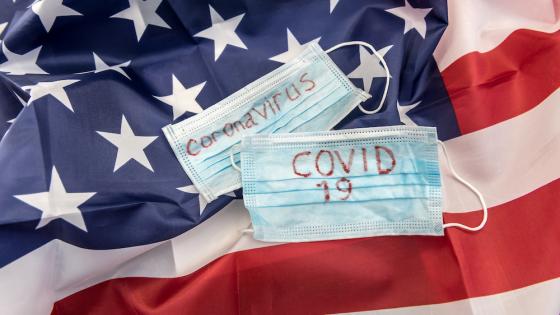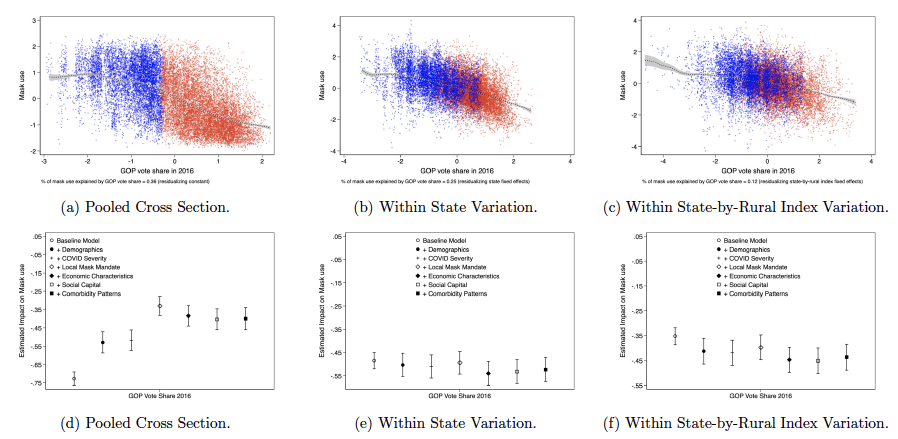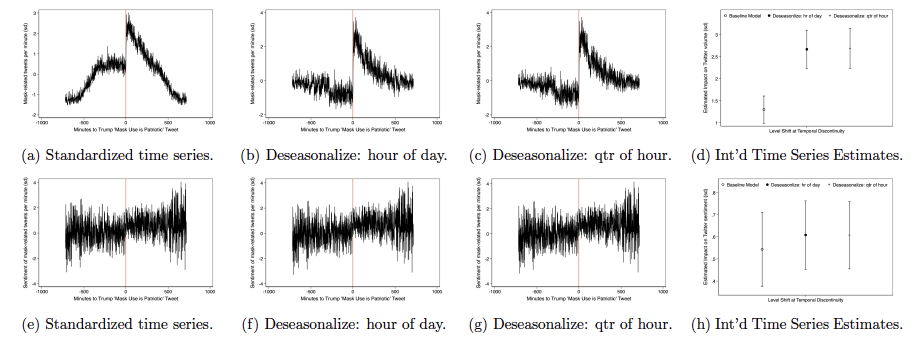Wearing face masks should be considered the least controversial of major public responses to COVID-19. Unlike with many other measures such as shelter-in-place ordinances, lockdowns, or capacity restrictions, there is no trade-off between mask use and economic activity. Several recent studies documented that masks can effectively diminish the spread of a viral respiratory infection (Mitze et al. 2020, Fischer et al. 2020, Chu et al. 2020, Leung et al. 2020), without disrupting economic activity (Howard et al. 2020). By contrast, social distancing has had an adverse effect on consumer activity (Goolsbee and Syverson 2020, Chetty et al. 2020, Coibion et al. 2020, Chronopoulos et al. 2020) and job losses (Friedson et al. 2020, Chudik et al. 2020, Gupta et al. 2020, Beland et al. 2020) and is itself influenced by economic conditions (Wright et al. 2020).
However, the public response to this seemingly uncontroversial measure has been significantly impeded by political polarisation. In the US, the single most important predictor of local mask use is not COVID-19 severity, demographic characteristics, religious affiliation, social capital or local policies such as mask mandates, but political partisanship. Mask mandates do have a significant effect in those localities which vote heavily Democratic, contrary to moderate or Republican localities.
In a recent paper (Milosh et al. 2020), we establish the role of political partisanship on use of masks by means of survey data at the zip code level. The dataset was compiled by the online market research firm Dynata on a request by the New York Times between 2 July and 14 July 2020 and included 250,000 responses across the US. Participants were asked to estimate how often they wear a mask when outside and around other people. We use these responses to construct our main measure: the probability that out of five people randomly encountered in a certain zip code, all five are wearing a mask. We then use vote shares from the 2016 election to measure partisanship. Our findings suggest that partisanship is one of the most important predictors of local mask use, and the gap between Republican and Democratic counties remains significant even in the presence of a local government mask mandates.
President Trump’s leadership on the issue also matters (Ajzenman et al. 2020). Following Trump's unexpected mask use at Walter Reed on 11 July 2020 and his endorsement of masks on 20 July 2020, there was an immediate and significant positive change in terms of social media engagement with and sentiment towards mask-related topics. Twitter users expressed more interest in mask-wearing. We can only speculate how much more Republican voters would wear masks if President Trump had consistently sent a pro-mask message.
The partisan divide over the 2020 pandemic is also documented by Barrios and Hochberg (2020) and Goldstein and Wiedemann (2020). They find that the gap between Democrats and Republicans manifests itself in different risk perception, interest in COVID-19, and social distancing behaviour (all of which are higher for Democrats). Further, the idea that political polarization might be detrimental to efficient governance has been explored before (McCarty 2007, Brady et al. 2008, Iyengar et al. 2019). We contribute to this literature by showing that political polarization does not need to work through long-term processes such as government gridlock or diminished trust in the government. Rather, the impact of political polarisation on public policy might be immediate.
Our research consists of four designs exploring the effects of political partisanship on mask wearing. First, we estimate the association between partisanship and mask use, starting with a simple bivariate correlation and then adding numerous potential covariates as well as alternative fixed effects specifications to account for potential confounding factors. We find that a one standard deviation shift in votes in favour of Donald Trump in the 2016 elections (18% swing) decreases mask use by 13.1% (p < 0.001). We then move to various regression specifications explaining the use of masks at the zip code level, adding all observable economic and demographic characteristics we can find, including indicators of local mask mandates, social capital, COVID-19 severity, and comorbidity patterns to account for potential confounders (Figure 1). The estimated effect of the Republican vote share on mask use stays negative and significant regardless of the specification.
Figure 1 Association between partisanship and mask use
Next, we zoom in on the mask mandates’ effect on mask prevalence. Mask mandates issued at the county and state level were collected by Wright et al. (2020). We find that these regulations are not able to close the partisan gap: in areas with strong support for Democrats (2016 Republican share less than 0.2), the mandates have led to a significant surge in mask use if masks were already pervasive. In contrast, in areas with a 2016 Republican share higher than 0.2, we observe no meaningful change after a mask wearing is mandated. All in all, policy interventions were unable to overcome the pre-existing partisan gap.
Figure 2 Effect of mask mandates on mask usage
Third, we turn to gauging where partisanship stands among other factors that can potentially predict mask use. To do that, we use the LASSO algorithm, a statistical method that is designed to select the most important predictors of the outcome variable (mask use) from a potentially large list of variables. Figure 3 shows that the Republican share is the strongest predictor of mask use, followed by local mask regulations, and the share of college graduates in the corresponding locality.
Figure 3 Predicators of mask use
Finally, we use a surprise appearance by President Trump as a quasi-experiment. On 11 July 2020, Donald Trump unexpectedly arrived at the Walter Reed National Military Medical Centre, wearing a face mask publicly for the first time. We measure mask-related engagement and sentiment on Twitter around this event, using it as a quasi-experimental shock to partisan messaging. We collected English language tweets mentioning mask-related keywords (such as ‘masks’ and ‘face covering’) between 6 July and 19 July, classifying the tweets by their sentiment on a negative-positive scale. We then collapse their volume and sentiment score by minute. To identify the exact moment of temporal discontinuity, we look for the very first tweet confirming Trump’s visit to the hospital.
Figure 4 depicts the jump in the number of mask-related tweets and their positive sentiment. The de-seasonalized tweet volume increased by a sizeable 4.24 standard deviations. Additionally, tweets published after the cut-off were more positive: the upward shift in sentiment was 1.02 standard deviations.
Figure 4 Discontinuity in mask-related tweets and their positive sentiment after Trump wore a mask in public
Figure 5 shows a similar quasi-experiment: it uses President Trump’s unexpected tweet promoting mask use as patriotic on 20 July. That tweet resulted in a 2.6 standard deviation rise in the volume of mask-related tweets, and a 0.6 standard deviation increase in positive sentiment.
Figure 5 Discontinuity in mask related tweets and positive sentiment after Trump’s tweet on mask wearing
Overall, our study provides robust evidence that political polarization has adversely impacted the implementation of an important health policy in the US.
References
Ajzenman, N, C Tiago and D Da Mata (2020), "Leaders' speech and risky behaviour during a pandemic", VoxEU.org, 2 May.
Barrios, J, and Y Hochberg (2020), “Risk Perception Through the Lens of Politics in the Time of the COVID-19 Pandemic”, NBER Working Paper 27008.
Beland, L P, A Brodeur, D Mikola, and T Wright (2020), “The Short-Term Economic Consequences of COVID-19: Occupation Tasks and Mental Health in Canada”, Working Paper.
Brady, D W, J Ferejohn, and L Harbridge (2008), Polarization and Public Policy: A General Assessment, Brookings Institution Press.
Chetty, R, J N Friedman, N Hendren, and M Stepner (2020), “How did Covid-19 and stabilization policies affect spending and employment? A new real-time economic tracker based on private sector data”, NBER Working Paper 27431.
Chronopoulos, D, M L and J O S Wilson (2020), “Real-time consumer spending responses to the COVID-19 crisis and government lockdown” , VoxEU.org, 6 May.
Chu, D K, E A Akl, S Duda, K Solo, S Yaacoub, H J Schünemann, A El-Harakeh, A Bognanni, T Lotfi, M Loeb (2020), “Physical distancing, face masks, and eye protection to prevent person-to-person transmission of SARS-CoV-2 and COVID-19: a systematic review and meta-analysis”, The Lancet 395(10242): 1973-1987.
Chudik, A, M H Pesaran and A Rebucci (2020), “Voluntary and mandatory social distancing: Evidence on Covid-19 exposure rates from chinese provinces and selected countries”, NBER Working Paper 27039.
Coibion, O, Y Gorodnichenko and M Weber (2020), “The cost of the Covid-19 crisis: Lockdowns, macroeconomic expectations, and consumer spending”, NBER Working Paper 27141.
Fischer, E P, M C Fischer, D Grass, I Henrion, W S Warren and E Westman (2020), “Low-cost measurement of face mask efficacy for filtering expelled droplets during speech”, Science Advances 6(36).
Friedson, A I, D McNichols, J J Sabia and D Dave (2020), “Did California’s shelter-in-place order work? Early Coronavirus-related public health effects”, NBER Working Paper 26992.
Goldstein, D and J Wiedemann (2020), “Who Do You Trust? The Consequences of Political and Social Trust for Public Responsiveness to COVID-19 Orders”, Working paper.
Goolsbee, A, and C Syverson (2020), “Fear, lockdown, and diversion: Comparing drivers of pandemic economic decline”, Journal of Public Economics 193: 104311.
Gupta, S, L Montenovo, T D Nguyen, F L Rojas, I M Schmutte, K I Simon and C Wing (2020), “Effects of social distancing policy on labor market outcomes”, NBER Working Paper 27280.
Howard, J, A Huang, Z Li, Z Tufekci, V Zdimal, H M van der Westhuizen, A von Delft, A Price, L Fridman, L H Tang and V Tang (2020), “Face masks against COVID-19: an evidence review”.
Iyengar, S, Y Lelkes, M Levendusky, N Malhotra and S J Westwood (2019), “The Origins and Consequences of Affective Polarization in the United States”, Annual Review of Political Science 22(1): 129-146.
Leung, N H, D K Chu, E Y Shiu, K H Chan, J J McDevitt, B JP Hau, H-L Yen, Y Li, D KM Ip, JS M Peiris, et al. (2020), “Respiratory virus shedding in exhaled breath and efficacy of face masks”, Nature Medicine 26(5): 676-680.
McCarty, N (2007), “The Policy Effects of Political Polarization”, Brookings Institution Press.
Milosh, M, M Painter, K Sonin, D Van Dijcke and A L Wright (2020), “Unmasking Partisanship: How Polarization Influences Public Responses to Collective Risk”, University of Chicago, Becker Friedman Institute for Economics Working Paper (2020-102).
Mitze, T, R Kosfeld, J Rode, and K Wälde (2020), “Face Masks Considerably Reduce COVID-19 Cases in Germany: A Synthetic Control Method Approach”, Working Paper.
Wright, A L, K Sonin, J Driscoll, and J Wilson (2020), “Poverty and economic dislocation reduce compliance with Covid-19 shelter-in-place protocols”, Journal of Economic Behavior and Organization 180: 544-554.
Wright, A L, G Chawla, L Chen, and A Farmer (2020), “Tracking Mask Mandates During the Covid-19 Pandemic”, University of Chicago, Becker Friedman Institute for Economics Working Paper (2020-104).













